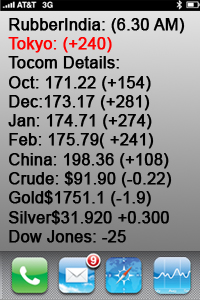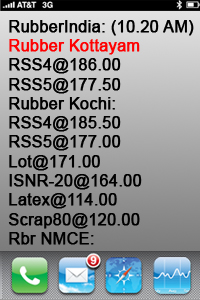February 18, 2025
Rubber India
Overview
Japanese rubber futures exhibited limited movement today as traders assess the impact of a stronger yen alongside China’s efforts to invigorate private sector confidence. Notably, demand for rubber from China, the largest consumer, continues to falter, contributing to a cautious market sentiment.
Market Highlights
Osaka July delivery (JRUc6) declined by 0.3 yen (0.08%) to 371.2 yen ($2.45) per kg.
SHFE May fell by 140 yuan (0.78%) to 17,755 yuan ($2,440.82) per metric ton.
The February butadiene rubber dropped 240 yuan (1.68%) to 14,010 yuan ($1,925.98) per metric ton.
SICOM March delivery last traded at 201.9 U.S. cents per kg, down 0.6%.
Currency Impact
The yen (JPY=EBS) held steady at 151.61 per dollar, gaining nearly 4% against the dollar since the beginning of 2025. A stronger yen reduces the affordability of yen-denominated assets for foreign buyers, adding pressure to prices.
Supply and Demand Dynamics
Production Trends:8 Recent reports indicate lower-than-expected rubber destocking at Qingdao port, while production in downstream companies has accelerated. However, poor shipment conditions are dampening raw material demand.
Chinese Market: Despite efforts by President Xi Jinping to engage with major technology leaders to bolster sentiment, overall economic growth remains sluggish, further impacting rubber demand.
Inventory Levels: As of February 9, 2025, total natural rubber inventory in Qingdao rose to 569,000 tons, indicating a 3% increase. The social inventory across China reached 1.363 million tons, reflecting ongoing accumulation amidst weak demand.
Outlook
The market is navigating mixed signals, with supply constraints from major producing regions like Vietnam and Northeast China due to seasonal harvesting suspensions. However, downstream manufacturers are primarily focused on depleting existing inventories rather than ramping up purchases.
As the Spring Festival concludes, an influx of natural rubber latex shipments is expected, which may increase spot circulation at ports. Despite rising cost support from decreased overseas supply, limited demand could lead to a volatile market landscape.
Key Considerations
Supply Shrinkage: Seasonal harvesting suspensions in key regions may lend support to rubber prices.
Weak Demand: Downstream manufacturers are cautious, limiting short-term purchasing activity.
Market Volatility: The interplay of rising costs and stagnant demand may result in continued price fluctuations.
In conclusion, the rubber market is characterized by a stalemate influenced by both supply constraints and weak demand, suggesting a complex environment for traders in the coming weeks.



